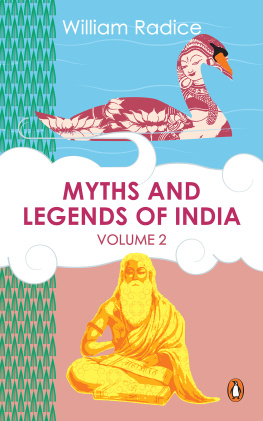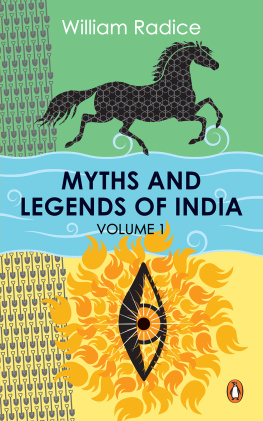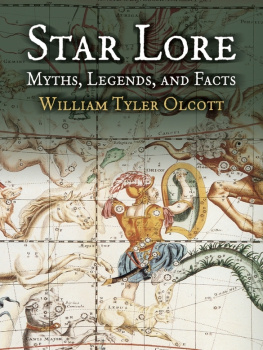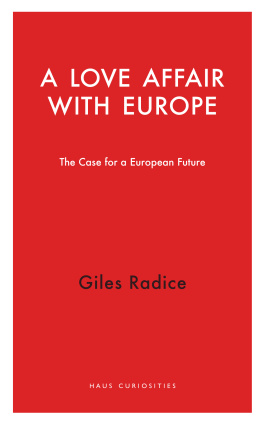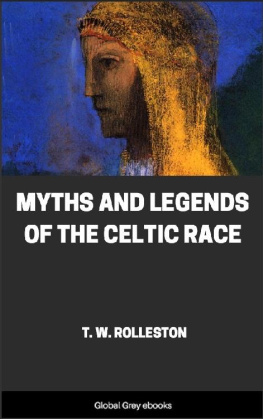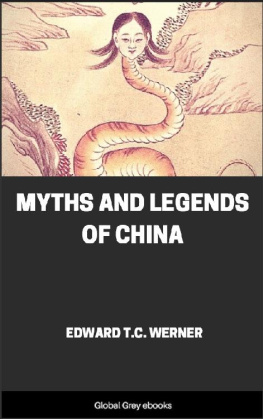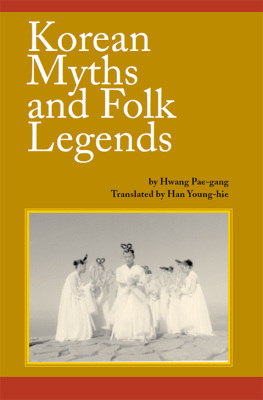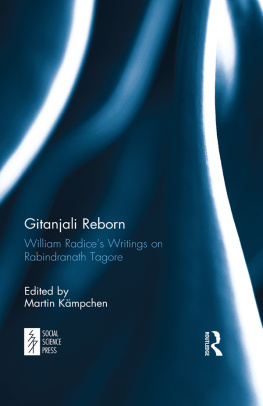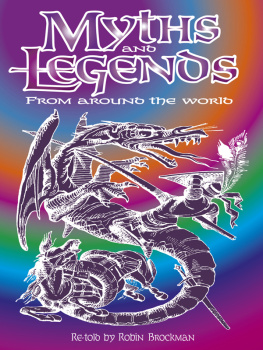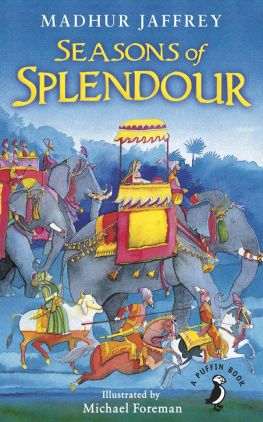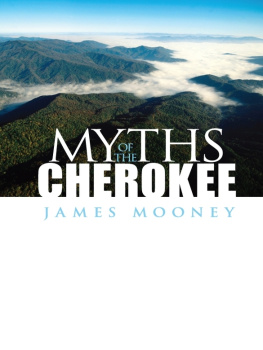William Radice - Myths and Legends of India Vol. 2
Here you can read online William Radice - Myths and Legends of India Vol. 2 full text of the book (entire story) in english for free. Download pdf and epub, get meaning, cover and reviews about this ebook. year: 2016, publisher: Penguin Books Ltd, genre: Art. Description of the work, (preface) as well as reviews are available. Best literature library LitArk.com created for fans of good reading and offers a wide selection of genres:
Romance novel
Science fiction
Adventure
Detective
Science
History
Home and family
Prose
Art
Politics
Computer
Non-fiction
Religion
Business
Children
Humor
Choose a favorite category and find really read worthwhile books. Enjoy immersion in the world of imagination, feel the emotions of the characters or learn something new for yourself, make an fascinating discovery.
- Book:Myths and Legends of India Vol. 2
- Author:
- Publisher:Penguin Books Ltd
- Genre:
- Year:2016
- Rating:3 / 5
- Favourites:Add to favourites
- Your mark:
- 60
- 1
- 2
- 3
- 4
- 5
Myths and Legends of India Vol. 2: summary, description and annotation
We offer to read an annotation, description, summary or preface (depends on what the author of the book "Myths and Legends of India Vol. 2" wrote himself). If you haven't found the necessary information about the book — write in the comments, we will try to find it.
Myths and Legends of India Vol. 2 — read online for free the complete book (whole text) full work
Below is the text of the book, divided by pages. System saving the place of the last page read, allows you to conveniently read the book "Myths and Legends of India Vol. 2" online for free, without having to search again every time where you left off. Put a bookmark, and you can go to the page where you finished reading at any time.
Font size:
Interval:
Bookmark:


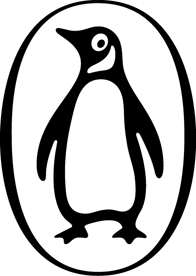
VOLUME 2

PENGUIN BOOKS

PENGUIN BOOKS
It appeared in a plainer hardback edition from Viking Penguin Books India in 2002. At a meeting at SOAS several years ago, Udayan Mitra of Penguin Indianow part of the Penguin Random House groupsuggested the book might do better as two separate volumes in paperback, and it is these, thanks mainly to kind assistance from Mrs Monwara Seetul, which are now published. In addition to the two-volume sharing of myths and folk-tales and Mahabharata extracts, and the revision and updating of the notes to the Introduction, cross-references have been largely removed. They were felt to be superfluous. In the glossary, however, cross-references to the elements in the Introduction have been retained. The list of sources that comes with each volume applies only to that volume.
It is something of a miracle, given the very serious accident that I met with in May 2013, that the book has appeared, and for this I give humble thanks. Above all, I hope readers will enjoy these tales.
He caught his breath. The Ocean of the Streams of Story, said the Water Genie, his blue whiskers bristling with pride. Wasnt it worth travelling so far and fast to see? Salman Rushdie, Haroun and the Sea of Stories Salman Rushdie used an ancient and familiar image when he wrote his enchanting fable about the storyteller Rashid and his son Haroun, in which Rashids storytelling gift is suddenly cut off when Kattam-Shudthe evil Prince of Silencepoisons and attempts to plug Kahani, the Sea of Stories. In about AD 1070, Somadeva, a Kashmiri Brahmin, wrote in Sanskrit his enormous and celebrated masterpiece, the Kathasaritsagara, which means the ocean [sagara] of streams [sarit] of story [katha]. Several of the stories in the present volume have been taken from that collection, which is like Ovid, Boccaccio, Chaucer and La Fontaine rolled into one; and versions of many stories that I have taken from other sources can also be found in it. Somadeva understood that, in Indian tradition, myths and legends and folk tales shade into one another, and that together they form a unity.
The metaphor of an ocean seems to be the only one huge and capacious enough to represent something so fluid, so deep, so changeable in mood, so beautiful yet often so frightening. The volumes that follow here are my own, reckless attempt to explore that Ocean. I invite you, the reader, to set sail with me, and stay aboard for as long as your daring or your energy lasts. You may sometimes feelas I often did when writing the bookthat you are in danger of sinking. But when you reach the shore again, I think you will feel exhilarated, and your life will never be the same again. As a specialist in Bengali language and literature, I have often been aware that the literary works I have studied or translated are like ships floating on the Indian Ocean of Stories.
By using dictionaries and reference books I have tried to understand what they owe to the Ocean; how, without it, they wouldnt float at all. But one has to embark on a longer, riskier voyageas, for the first time, I have in this bookto appreciate its full extent and variety. To convey that range, here are some notes on just a few of the ships in which I have previously sailed. Some of them, through translation or through transformation into divergent media, have travelled to other oceans, to float on waters from the Western tradition. The Poetry of Michael Madhusudan Dutt (18241873). Acknowledged as the founder of modern Bengali poetry and drama, Madhusudan could not have conceived his masterpiece, the epic poem Meghnad Badh Kabya, written in the early 1860s, without Indias epic and mythological tradition. Based on the story of the Ramayanawhich tells of the abduction of Ramas wife, Sita, by Ravana, the demonic king of Lanka, and her rescue by Rama and his brother Lakshmana, assisted by the monkey-god Hanumanit concentrates on the death of Ravanas son Meghnad and on Ravanas final defeat, projecting both father and son as tragic heroes rather than as demons.
Madhusudan was a Christian convert, and was very well read in European literature. His poem was influenced in its structure and tone by Homer, Virgil, Dante and Milton; but the depths of the Ocean on which he sailed were Indian. He made this plain in his exuberant English letters: I am going on with Meghnad by fits and starts. Perhaps the poem will be finished by the end of the year. I am glad you like the opening lines. I must tell you, my dear fellow, that though, as a jolly Christian youth, I dont care a pins head for Hinduism, I love the grand mythology of our ancestors.
It is full of poetry. A fellow with an inventive head can manufacture the most beautiful things out of it. Madhusudan was the subject of my D.Phil. thesis (1987); but I havent really plumbed his mythological depths until now. The Poetry of Rabindranath Tagore (18611941). The great Bengali poet, whose works I have been reading and translating for most of my adult life, constructed numerous ships that sailed on the Ocean, and several of them can be found in the Selected Poems of Tagore that I translated for Penguin. Another fine poem by Tagore, not included in my Penguin book, is To Ahalya, first published in 1890.
In The Seduction of Ahalya (Volume Two, pp. 9092), I have retold the various versions that exist of this myth. In his poem, Tagore does not focus on how or why Ahalya was cursed; instead, he is fascinated by her state of consciousness after she has been turned into a stone, and by what goes through her mind when she is restored to life by the touch of Ramas foot. At the end of the poem, Tagore himself uses an ocean metaphor, which will remind Indian readers of the emergence of Vishnus wife, Lakshmi, from the churning of the primeval World-Ocean, and Westerners of Botticellis
Font size:
Interval:
Bookmark:
Similar books «Myths and Legends of India Vol. 2»
Look at similar books to Myths and Legends of India Vol. 2. We have selected literature similar in name and meaning in the hope of providing readers with more options to find new, interesting, not yet read works.
Discussion, reviews of the book Myths and Legends of India Vol. 2 and just readers' own opinions. Leave your comments, write what you think about the work, its meaning or the main characters. Specify what exactly you liked and what you didn't like, and why you think so.

